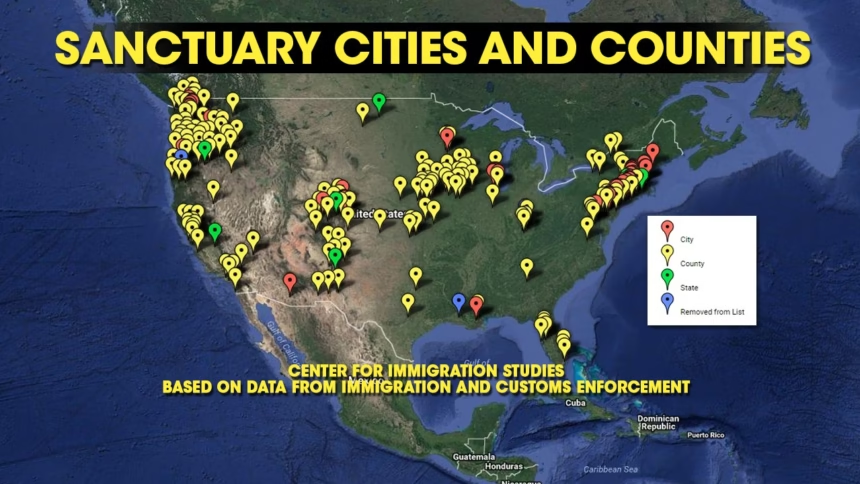Opinion | Emmanuel Paul
As the United States prepares for former President Donald Trump’s return to office in 2025, the immigration landscape is experiencing another significant transformation. With mounting concerns among immigrant communities nationwide, the significance of “sanctuary cities and states” has reached new heights. This comprehensive analysis explores the fundamentals of sanctuary jurisdictions, their operational mechanisms, and provides an up-to-date compilation of sanctuary locations as of November 2024.
What Are Sanctuary Cities and States?
According to the Center for Immigration Studies, a nonpartisan research organization dedicated to U.S. immigration studies, sanctuary cities and states are jurisdictions that implement policies designed to minimize their collaboration with federal immigration enforcement authorities. These policies typically encompass:
- Rejection of ICE Detainer Requests: Local police departments may choose not to detain individuals for ICE unless presented with a court-issued warrant.
- Limited Information Exchange: Certain jurisdictions implement barriers to prevent local agencies from sharing individuals’ immigration status with federal immigration authorities.
- Local Community Safeguards: Numerous sanctuary cities emphasize building confidence between immigrant populations and law enforcement, enabling undocumented residents to access public services or report criminal activities without deportation fears.
These jurisdictions strive to maintain equilibrium between community safety and protecting immigrant populations from intensive immigration enforcement. However, the specific policies and level of federal cooperation vary significantly among different locations.
What It Means for Immigrants Under the Incoming Trump Administration
Trump’s initial presidency was marked by aggressive opposition to sanctuary jurisdictions, including attempts to withdraw federal funding, intensify immigration raids, and expand enforcement operations in these areas. He consistently opposed sanctuary policies, arguing they protected lawbreakers.
With his anticipated return to power, these enforcement strategies are likely to be reinstated and strengthened. Immigrants, particularly those without documentation, should prepare for:
- Enhanced Deportation Risks: Even minor legal violations could trigger ICE involvement, particularly in regions without sanctuary protections.
- Intensified Pressure on Sanctuary Areas: The incoming administration is expected to increase pressure on these jurisdictions through legal challenges and funding restrictions.
- Reduced Protection Outside Sanctuary Zones: Immigrants in non-sanctuary areas may face greater risks due to complete local law enforcement cooperation with ICE.
While relocating to a sanctuary jurisdiction might offer some protection for immigrants, as these areas generally prioritize local regulations over federal immigration enforcement, it’s crucial to understand that sanctuary status doesn’t guarantee complete immunity from deportation. While violent offenders typically don’t receive protection under sanctuary policies, some states maintain certain protective measures. However, in most cases, individuals who commit serious crimes are transferred to federal authorities for deportation proceedings.
Furthermore, the federal government retains the authority to override a jurisdiction’s sanctuary designation if deemed necessary, though such actions typically result in legal confrontations between federal and state authorities.
In 2011, during the Obama presidency, a significant “sensitive locations” directive was implemented, prohibiting Immigration and Customs Enforcement (ICE) from conducting immigrant searches in designated areas including educational institutions, religious facilities, healthcare centers, and similar locations. However, this policy included specific exemptions for urgent situations, such as cases involving individuals posing immediate threats, or when agents have secured appropriate higher-level authorization for enforcement actions.
Paul Hunker, who serves as a Catholic and previously worked as ICE’s chief counsel in Dallas, viewed Morton’s 2011 policy memo as a well-balanced and practical directive. Speaking to Catholic News Agency (CNA), he described it as “a thoughtfully constructed document that strikes an appropriate balance.”
Hunker noted that the memo maintains flexibility in ICE operations. When unauthorized immigrants seek refuge in designated “sensitive locations” like churches, ICE retains authority to act if public safety is at risk or if senior officials determine intervention necessary.
The Biden administration reinforced the 2011 prohibition in 2021. However, incoming president Donald Trump has indicated his intention to remove these limitations by permitting ICE to conduct arrests anywhere, including churches, educational facilities, medical centers, and other currently protected spaces.
In his discussion with the Catholic News Agency (CNA), Paul Hunker suggested that eliminating this policy could prove “counterproductive” as it might generate anxiety among undocumented populations, reducing their willingness to seek assistance from religious institutions including the Catholic Church. He views this change as an intimidation strategy that could yield negative effects.
“Our churches should be welcoming spaces for everyone, regardless of documentation status,” Hunker remarked. “This policy shift might deter attendance… I suspect it’s one component of a larger governmental effort to encourage voluntary departures through intimidation.”
Updated Sanctuary Cities and States List
According to the Center for Immigration Studies’ November 1, 2024 update, their sanctuary jurisdiction inventory has expanded by 170 new locations. These jurisdictions continue to adopt policies that restrict federal immigration enforcement activities.
District of Columbia
Washington
Georgia
Athens-Clarke County
Atlanta
Columbia County
DeKalb County
Douglas County
Idaho
Power County
Indiana
Lake County
Monroe County
St. Joseph County
Wayne County
Kansas
Douglas County
Kentucky
Campbell County
Franklin County
Jefferson County
Louisville
Scott County
Louisiana
New Orleans
Maine
Cumberland County
Hancock County
Maryland
Baltimore
Baltimore County
Charles County
Howard County
Hyattsville
Montgomery County
Prince George’s County
Queen Anne’s County
Rockville
St. Mary’s County
Michigan
Kalamazoo County
Kent County
Lansing
Leelanau County
Luce County
Muskegon County
Oakland County
Washtenaw County
Wayne County
Wexford County
Minnesota
Anoka County
Cottonwood County
Dakota County
Hennepin County
Jackson County
Kandiyohi County
Lincoln County
Lyon County
Nobles County
Pipestone County
Ramsey County
Watonwan County
Nebraska
Arthur County
Banner County
Blaine County
Douglas County
Gosper County
Greeley County
Hooker County
Howard County
Logan County
McPherson County
Platte County
Sioux County
New Hampshire
Hillsborough County
New Mexico
Bernalillo County
Chaves County
Colfax County
De Baca County
Dona Ana County
Eddy County
Farmington
Grant County
Hidalgo County
Las Cruces
Lincoln County
Los Alamos County
Luna County
McKinley County
Otero County
Quay County
Rio Arriba County
Roosevelt County
San Juan County
San Miguel County
Sandoval County
Santa Fe
Santa Fe County
Sierra County
Socorro County
Taos County
New York
Albany
Albany County
Dutchess County
Monroe County
Nassau County
New York City
Orange County
Putnam County
Rockland County
Saratoga County
Suffolk County
Sullivan County
Tompkins County
Ulster County
Warren County
Wayne County
Westchester County
Yates County
North Carolina
Buncombe County
Chatham County
Durham County
Forsyth County
Guilford County
Mecklenburg County
Orange County
Wake County
Watauga County
Ohio
Franklin County
Hamilton County
Lorain County
Mahoning County
Pennsylvania
Allegheny County
Berks County
Bucks County
Chester County
Delaware County
Lancaster
Lehigh County
Mifflin County
Montgomery County
Montour County
Northampton County
Philadelphia
Washington County
South Carolina
Charleston County
Tennessee
Shelby County
Virginia
Albemarle County
Alexandria
Alleghany County
Amherst County
Appomattox County
Ashland
Arlington County
Augusta County
Bath County
Bedford
Bedford County
Brunswick County
Buchanan County
Campbell County
Caroline County
Charles City County
Charlotte County
Charlottesville
Chesapeake
Chesterfield County
Colonial Heights
Covington
Dickenson County
Dinwiddie County
Dumfries
Emporia
Essex County
Fairfax County
Franklin
Gloucester County
Greensville County
Halifax County
Hampton
Hanover County
Harrisonburg
Haymarket
Hopewell
Isle of Wight County
James City County
King and Queen County
King William County
Lee County
Loudoun County
Lynchburg
Manassas
Manassas Park
Martinsville
Mathews County
Mecklenburg County
Middlesex County
Nelson County
Newport News
Norfolk
Northumberland County
Norton
Occoquan
Petersburg
Poquoson
Portsmouth City
Prince George County
Prince William County
Quantico
Rappahannock County
Richmond
Richmond County
Rockingham County
Russell County
Scott County
Shenandoah County
Smyth County
Southampton County
Staunton
Suffolk
Surry County
Tazewell County
Virginia Beach
Warren County
Warsaw
Washington County
Waynesborough
Westmoreland County
Williamsburg
Wise County
York County
Wisconsin
Dane County
Milwaukee County
Winnebago Correctional Center (state facility)
Wyoming
Teton County
Remarks:
Among all U.S. states, Florida hosts one of the largest immigrant populations, with Haitian communities forming a significant demographic group. However, Florida’s absence from the list is notable. The state’s leadership under Republican Governor Ron DeSantis, a prominent MAGA supporter and conservative hardliner, influences its immigration policies. Similar to other Republican-governed states, Florida grants ICE extensive authority to conduct immigration enforcement operations and detain individuals without restrictions. Nevertheless, certain Democrat-controlled municipalities may challenge these practices through legal action against the federal government, but the federal government is largely expected to gain the support from other governmental branches in the U.S., given the Republican party’s current dominance across all three branches of government (Executive, Legislative, and Judiciary).
Can Sanctuary Status Change?
Indeed, a region’s sanctuary designation may shift depending on electoral outcomes and changes in political leadership. Measures protecting immigrant communities typically reflect the stance of officials at municipal or state levels. Consider these patterns:
- Democratic-Led Regions: These typically sustain protective immigrant policies.
- Republican-Led Regions: These often eliminate sanctuary protections, harmonizing with federal immigration enforcement priorities under conservative leadership.
Therefore, residents in sanctuary zones should stay alert to potential policy modifications.
What Sanctuary Cities and States Mean for Immigrants
For immigrants concerned about stricter federal immigration policies, moving to a sanctuary jurisdiction might provide additional safeguards. However, this remains a highly individual choice based on personal situations. Key considerations include:
- Family and Community Bonds: Relocation could separate established social networks.
- Career Prospects: Sanctuary areas may present work possibilities but might face economic challenges due to political decisions.
- Service Accessibility: Sanctuary locations typically ensure better public service access without immigration status verification.
Immigrants should thoroughly assess their situations and consult immigration experts before such major decisions.
Final Thoughts
During periods of political transformation, sanctuary jurisdictions may serve as essential havens for immigrant protection. While these areas cannot guarantee complete immunity from federal action, they represent hope amid growing uncertainty. CTN encourages all immigrants to maintain awareness, build connections with advocacy organizations, and evaluate necessary measures to protect their families and prospects. We pledge our continued support throughout your journey.
At Caribbean Television Network (CTN), we recognize the vital challenges confronting immigrant populations, especially those with Caribbean heritage. Our purpose centers on providing you with precise, useful information to handle these challenging times. Our analysts have dedicated themselves to creating this detailed guide, and we’ll continue tracking sanctuary policy developments under changing federal leadership. Should you or your family members require guidance about your rights or relocation possibilities, reach out to immigration attorneys or local support groups for professional guidance.







